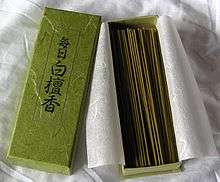Nippon Kodo
Nippon Kodo (日本香堂) is a Japanese incense company who trace their origin back over 400 years to an incense maker known as Koju, who made incense for the Emperor of Japan. The Nippon Kodo Group was established in August 1965, and has acquired several other incense companies worldwide and has offices in New York City, Los Angeles, Paris, Chicago, Hong Kong, Vietnam, and Tokyo.[1] Mainichi-Koh, introduced in 1912, is the company's most popular product.

History
The company traces its roots back over 400 years to Jyuemon Takai, known as Koju, an incense maker to the Emperor of Japan.[2] The Nippon Kodo Group was established in August 1965. It has acquired several other incense companies worldwide and has offices in Los Angeles, Paris, Chicago, Hong Kong, Vietnam, and Tokyo. The company's name means Japanese incense store.

Brands
Nippon Kodo has several brands of incense, each consisting of several different fragrances. The most popular brand is "Morning Star", whose scents include Sandalwood, Cedar, and vanilla, and which is sold internationally. Other brands include Mainichi-Koh, which is Nippon Kodo's most popular product, introduced in 1912.[3]
- Tokusen Mainichi-Koh, Nippon Kodo's deluxe version of Mainichi-Koh
- Seiun, Nippon Kodo's most popular smokeless product
- Jinkō Seiun, Nippon Kodo's most popular aloeswood incense
- Gozan-kōh, granulated incense used by many temples, often shipped in bulk
- Kataribe
- Hanaizumi
- Tendan
- Kafū
- Eiju
- Taiyō
- Seiten
- Kazedayori
- Shibayama
- Setsugekka/Hanamidō
- Dentōdō
There are 4 incenses in Nippon Kodo's Traditional Series. These incenses contain ingredients of the Nippon Kodo collection.
- Everyday Sandalwood (Mainichi Byakudan)
- Fortune Mountain Agarwood (Jinkō Juzan)
- Diamond Kyara (Kyara Kongō)
- Great Prospects Kyara (Kyara Taikan)
See also
- Japanese Incense Ceremony
References
- "The Nippon Kodo Group".
- Hoover's. "Nippon Kodo Co., Ltd. | Company Profile from Hoover's". hoovers.com. Retrieved 27 February 2013.
- "Mainichi-Koh". nipponkodo.com. Retrieved 27 February 2013.